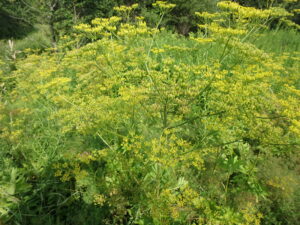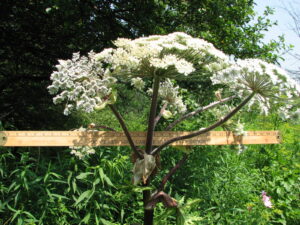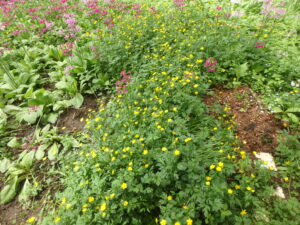Plants to Avoid If You Can
Posted on Tuesday, July 19, 2022 · Leave a Comment
This is the time of year when wild parsnips are in full bloom. They stand anywhere from two to six feet tall, and are topped with clusters of tiny flowers facing upward and arranged in a flat cluster called an umbel. The blossoms are similar to those on Queen Anne’s lace, but yellow.

Wild parsnips often grow along the roadside. Many people are easily burned by the sap.
Avoid wild parsnips because you can get terrible burns from the sap of this plant. When the sap on you is hit by bright sunshine, most people develop painful blisters. This is unfortunate, as this common plant is spread by seed, often creating large patches in fields and along roadsides. If you get sap on you, wash it off with soap and water immediately, cover the area, and stay out of direct sunshine for 48 hours.
How can you get rid of wild parsnips? Wild parsnips are biennials – meaning they die after blooming in their second year. I’ve read that mowing a patch of them right after they bloom (but before they produce seeds) will get rid of them, but only if you do this for three to five years. Presumably the repeated mowing is needed to kill plants that come back from seeds that did not germinate in year one.

Giant hogweed is an invasive that can burn you with its sap.
Giant hogweed (Heracleum mantegazzianum) is in the same family as parsnips, but is bigger, harder to get rid of, and even more toxic. I saw it for sale some 20 years ago and was intrigued by its size (6 to 12 feet tall) and blossoms that are up to three feet across. I bought it and planted it, having been told that it was not a perennial, though it is.
Even though I didn’t know its sap could cause burns, I quickly decided that giant hogweed was not a plant I wanted – it popped up 50 feet away from where I planted it, and could grow in full sun or full shade, wet soil or dry. I decided it had potential to be a thug.
At first I just cut off the flower heads before they produced seeds, but in year two or three I decided to pull it by the roots, I was lucky that I was able to get out the roots which can go down two feet or more. And even more fortunately, either I did not get sap on me, or I am not allergic to it. It is not widely distributed in New England, though it is a real pest in parts of California and elsewhere.
I was less fortunate when it came to getting rid of the Japanese butterbur (Petasites japonicus) I purchased long ago. I was told that yes, it could run, but it was easy to contain with a lawnmower or a stream. Not so. This plant can send roots 20 feet or more, then send up new plants. It is an aggressive plant that will smother almost any other. It likes moisture, and does well in shade as well as sun.
Depending on the variety, this plant can produce clumps of huge leaves that stand up to five feet tall. It has small flowers that erupt from the soil before the leaves. The roots go down deep and break easily, making it tough to remove. In its native Japan, it is considered an edible, but I have no interest in eating it.
I have lost control of our Japanese butterbur. It crossed the stream and gone under the lawn to other beds, and generally become a pest. Even though it is interesting to look at, enough is enough! I wish I had never bought it!

Buttercups are pretty but tough to control
Another pest I have will surprise you, perhaps: buttercups (Ranunculus repens). Like some of the others mentioned above, at first I welcomed this bright harbinger of spring which displays cheerful yellow blossoms. But it has become a problem because it spreads not only by root, but by seed, and once established it is difficult to weed out. And it will choke out other plants. It is glorious in bloom, but very tenacious. If you have moist, rich soil in part shade, watch out. I’d advise removing it early before it starts crowding out other plants. This one is native to Europe, but there are native species that are not a problem, I am told.
Years ago a friend gave me some iris that had the roots of goutweed (Aegopodium podagraria) tangled in with the iris roots. It quickly took over the iris bed, choking out everything else. A native of Asia and parts of Europe, it can form a dense mat that outcompetes everything else. The roots are brittle, and thus hard to remove. Even a scrap of root can start a new plant.

Goutweed will outcompete any other plants and is difficult to eradicate
I dug out all the goutweed, took away the soil down to 12 inches and replaced the soil after putting down a heavy weed mat. Still … 5 years later it crawled out from under the mat. If you have it, accept you will probably always have it, though with persistence and a good weeding tool, it is possible to control. But I wouldn’t buy a house that has it!
A variegated form of goutweed called ‘Snow on the Mountains’ has green and white leaves and was sold as a groundcover in the past. But sometimes it reverts back to the more aggressive all-green form and tries to take over the world. So avoid both forms.
Let’s face it: plants take advantage of us if they can. We like good looking, interesting plants, so they put on a good show. But among the good ones, there are those aggressive thugs that deserve no mercy. All you can do is be attentive, and act quickly when a new plant starts to take over your gardens.
Henry is the author of 4
gardening books, and a lifetime UNH Master
Gardener. Reach him at PO Box 364, Cornish Flat, NH 03746 or by e-mail at
henry.homeyer@comcast.net.






